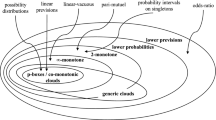Abstract
We study decision under uncertainty in an Anscombe–Aumann framework. Two binary relations characterize a decision-maker: one (in general) incomplete relation, reflecting her objective rationality, and a second complete relation, reflecting her subjective rationality. We require the latter to be an extension of the former. Our key axiom is a dominance condition. Our main theorem provides a representation of the two relations. The objectively rational relation has a Bewley-style multiple prior representation. Using this set of priors, we fully characterize the subjectively rational relation in terms of the most optimistic and most pessimistic expected utilities.
Similar content being viewed by others
Notes
Strictly speaking, the version of continuity which we have listed is stronger than the one that appears in GMMS, while the independence axiom is weaker. However, as GMMS note in their final technical remarks on p 769, Shapley and Baucells (1998) have shown that, in the presence of Preorder, this stronger continuity axiom and this weaker independence axiom imply the independence axiom that GMMS use. Conversely, the representation of \(\succsim ^*\) that they obtain in their theorems implies the stronger continuity axiom.
References
Anscombe, F., & Aumann, R. (1963). A definition of subjective probability. The Annals of Mathematics and Statistics, 34, 199–205.
Aumann, R. J. (1962). Utility theory without the completeness axiom. Econometrica, 30(3), 445–462.
Bewley, T. (2002). Knightian decision theory. Part I. Decisions in Economics and Finance, 25, 79–110.
Binmore, K. G. (2009). Rational decisions. Princeton: Princeton University Press.
Bridges, D. S., & Mehta, G. B. (1995). Representations of preference orderings, volume 422 of lecture notes in economics and mathematical systems. Berlin: Springer.
Buck, P. S. (1959). The bomb—the end of the world? The American Weekly, 8–11.
Cerreia-Vioglio, S. (2016). Objective rationality and uncertainty averse preferences. Theoretical Economics, 11(2), 523–545.
Cerreia-Vioglio, S., Giarlotto, A., Greco, S., Maccheroni, F., & Marinacci, M. (2020). Rational preference and rationalizable choice. Economic Theory, 69(1), 61–105.
Cerreia-Vioglio, S., Maccheroni, F., Marinacci, M., & Montrucchio, L. (2011). Uncertainty averse preferences. Journal of Economic Theory, 146(4), 1275–1330.
Chateauneuf, A., Eichberger, J., & Grant, S. (2007). Choice under uncertainty with the best and worst in mind: Neo-additive capacities. Journal of Economic Theory, 137(1), 538–567.
Davis, N. P. (1968). Lawrence and Oppenheimer. New York: Simon and Schuster.
Dubra, J., Maccheroni, F., & Ok, E. A. (2004). Expected utility theory without the completeness axiom. Journal of Economic Theory, 115(1), 118–133.
Eichberger, J., Kelsey, D., & Schipper, B. C. (2008). Ambiguity and social interaction. Oxford Economic Papers, 61(2), 355–379.
Faro, J. H., & Lefort, J.-P. (2019). Dynamic objective and subjective rationality. Theoretical Economics, 14(1), 1–14.
Fishburn, P. (1970). Utility theory for decision making. New York: Wiley.
Ghirardato, P., Maccheroni, F., & Marinacci, M. (2004). Differentiating ambiguity and ambiguity attitude. Journal of Economic Theory, 118(2), 133–173.
Gilboa, I., Maccheroni, F., Marinacci, M., & Schmeidler, D. (2010). Objective and subjective rationality in a multiple prior model. Econometrica, 78(2), 755–770.
Gilboa, I., & Schmeidler, D. (1989). Maxmin expected utility with non-unique prior. Journal of Mathematical Economics, 18, 141–153.
Grant, S., Rich, P., & Stecher, J. (2020). Worst- and best-case expected utility and ordinal meta-utility.
Gul, F., & Pesendorfer, W. (2015). Hurwicz expected utility and subjective sources. Journal of Economic Theory, 159, 465–488.
Hansen, L. P., & Sargent, T. J. (2001). Robust control and model uncertainty. American Economic Review, 91(2), 60–66.
Hurwicz, L. (1951). Optimality criteria for decision making under ignorance. Discussion Paper, Statistics 370, Cowles Commission.
Klibanoff, P., Marinacci, M., & Mukerji, S. (2020). A smooth model of decision making under ambiguity. Econometrica, 6, 1849–1892.
Maccheroni, F., Marinacci, M., & Rustichini, A. (2006). Ambiguity aversion, robustness, and the variational representation of preferences. Econometrica, 74(6), 1447–1498.
Manski, C. F. (1981). Learning and decision making when subjective probabilities have subjective domains. The Annals of Statistics, 9(1), 59–65.
May, K. O. (1954). Intransitivity, utility, and the aggregation of preference patterns. Econometrica, 22(1), 1–13.
Ok, E. A. (2002). Utility representation of an incomplete preference relation. Journal of Economic Theory, 104(2), 429–449.
Seidenfeld, T., Mark J Schervish, M. J., & Kadane, J. B. (1995). A representation of partially ordered preferences. The Annals of Statistics, 23(6), 2168–2217.
Seidenfeld, T., & Wasserman, L. (1993). Dilation for sets of probabilities. The Annals of Statistics, 21(3), 1139–1154.
Shapley, L. S., & Baucells, M. (1998). A theory of multiperson utility. Working Paper 779, UCLA.
Siniscalchi, M. (2009). Vector expected utility and attitudes toward variation. Econometrica, 77(3), 801–855.
Stecher, J. D. (2008). Existence of approximate social welfare. Social Choice and Welfare, 30(1), 43–56.
Strzalecki, T. (2011). Axiomatic foundations of multiplier preferences. Econometrica, 79(1), 47–73.
Wald, A. (1950). Statistical decision functions. New York: Wiley.
Author information
Authors and Affiliations
Corresponding author
Additional information
Publisher's Note
Springer Nature remains neutral with regard to jurisdictional claims in published maps and institutional affiliations.
Rights and permissions
About this article
Cite this article
Grant, S., Rich, P. & Stecher, J. Objective and subjective rationality and decisions with the best and worst case in mind. Theory Decis 90, 309–320 (2021). https://doi.org/10.1007/s11238-020-09777-x
Accepted:
Published:
Issue Date:
DOI: https://doi.org/10.1007/s11238-020-09777-x




